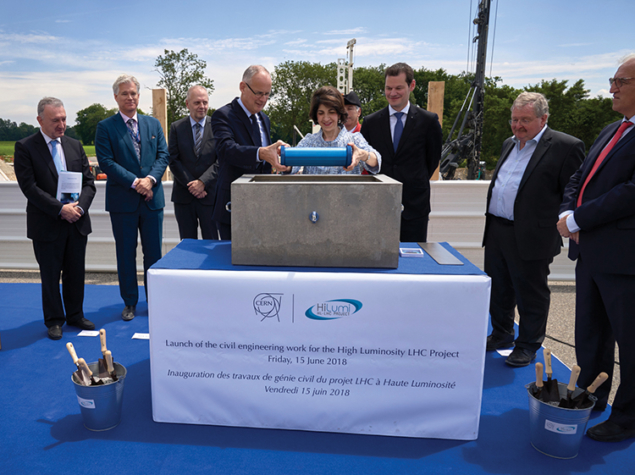
A ceremony at CERN on 15 June celebrated the start of civil-engineering works for the high-luminosity upgrade of the Large Hadron Collider (HL-LHC). The upgrade will allow about 10 times more data to be accumulated by the LHC experiments between 2026 and 2036, corresponding to a total integrated luminosity of 3000 fb–1, thereby enhancing the chances of discovery and bringing increased precision to measurements.
The HL-LHC project began in earnest in November 2011 as an international endeavour today involving 29 institutes from 13 countries. Two years later, the project was identified as one of the main priorities of the European Strategy for Particle Physics. The upgrade, targeting a luminosity of at least 5 × 1034 cm–2 s–1, was formally approved by the CERN Council in June 2016.
Although it concerns only about 5% of the current machine, the HL-LHC is a major upgrade requiring a number of innovative technologies, many of which pave the way for future higher-energy colliders. At its heart are powerful new dipole and quadrupole magnets that operate at unprecedented fields of 11 and 11.5 T, respectively, and which employ novel niobium-tin superconducting cables. The quadrupoles, which will be installed on both sides of the collision points, will squeeze the proton beams to increase the probability of a collision (CERN Courier March 2017 p23).
Sixteen brand-new radio-frequency “crab cavities” will also be installed around the ATLAS and CMS experiments to maximise the overlap of the proton bunches at the collision points (CERN Courier May 2018 p18). Their function is to tilt the bunches so that they appear to move sideways, and the first ever tests of this technology in a proton beam were successfully carried out at the Super Proton Synchrotron in May.
To prepare the CERN accelerator complex for the immense challenges of the HL-LHC, the LHC Injectors Upgrade project (LIU) was launched in 2010. In addition to enabling the necessary injector chains to deliver the HL-LHC beams, the LIU project is also tasked with replacing ageing equipment and improving radioprotection measures (CERN Courier October 2017 p32).
Overall, more than 1.2 km of the current LHC will need to be replaced with new components. This requires civil-engineering work at two main sites in Switzerland and in France, involving the construction of new buildings, shafts, caverns and underground galleries (CERN Courier March 2017 p28). The LHC will continue to operate until
early December.
“The High-Luminosity LHC will extend the LHC’s reach beyond its initial mission, bringing new opportunities for discovery, measuring the properties of particles such as the Higgs boson with greater precision, and exploring the fundamental constituents of the universe ever more profoundly,” said CERN Director-General Fabiola Gianotti during the ceremony.
On 25 June, the Canadian government announced a contribution of C$10 million to the HL-LHC, with an additional C$2 million in in-kind contributions. Working with Canadian researchers and industry, the TRIUMF laboratory will lead the production of five cryogenic modules for the HL-LHC crab cavities.







